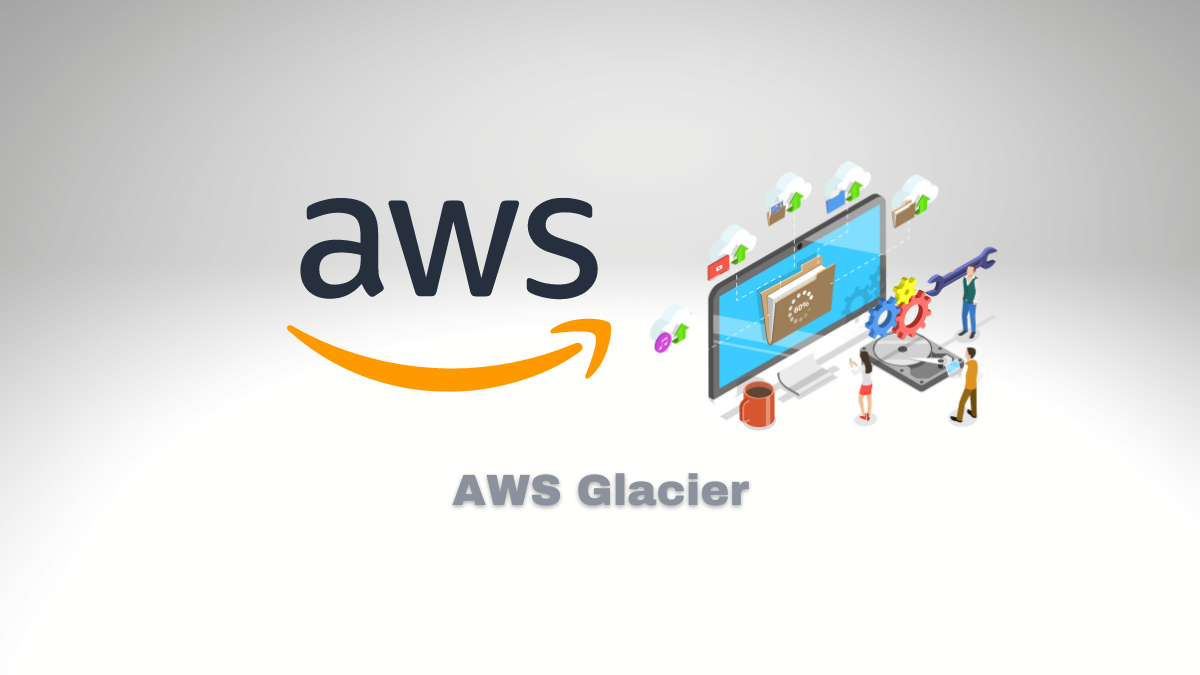The Essential Guide to AWS Glacier

A great strategy to implement an effective backup solution for critical data is essential for any business. Regardless of the type of business, having robust backups will ensure that critical information and files are safe in case of a disaster or system failure. Without proper backups, organizations can suffer significant losses as they may not be able to recover critical documents or access customer records.
Creating a comprehensive backup strategy is the first step to ensuring data integrity. It should include local and off-site backups, with several different methods used for storing data. This will help protect against any loss, including physical damage or theft, cyberattacks, and natural disasters. The exact plan depends on the size of the business and its specific needs, but it should include regular backups and emergency plans.
Once a backup strategy is in place, organizations must ensure it is regularly tested and updated. Regular testing will help ensure that backups are still working correctly, while updating them regularly will ensure that all critical data is backed up at least once every few weeks.
AWS – Archive Solution
Learning AWS, it’s crucial today for your business. Download our AWS Learning Kit to boost your skills.
Amazon Web Services (AWS) offers various products for designing an archive solution. For example, the AWS Storage Gateway is a cloud-based storage service that provides on-premises applications with secure, durable access to data stored in the AWS cloud. In addition, it offers on-premises applications and gateways with access to a wide variety of AWS storage services, such as Amazon S3 and Glacier.
Amazon Glacier and S3 Inventory
Amazon Web Services (AWS) offers two different services, S3 Inventory, and Amazon Glacier, to help manage data storage in the cloud. S3 Inventory provides detailed reports about the objects stored in an S3 bucket which can be used for compliance, audit, or data analysis. Amazon Glacier is a service designed for long-term data archiving, providing secure, low-cost storage for infrequently accessed information. The reports from S3 Inventory can be used to identify which data from the bucket should be moved to Glacier for archiving to reduce storage costs while maintaining data accessibility. In short, S3 Inventory and Amazon Glacier work together to help manage and optimize data storage in the cloud.
Glacier Instant Retrieval
AWS Glacier Instant Retrieval is a feature of AWS Glacier that allows users to access data stored in the cloud immediately instead of waiting for hours or days. This speeds up recovery times and reduces costs associated with manual retrievals. Glacier Instant Retrieval supports single-file and bulk retrieval requests, making it useful for various scenarios. It also allows for flexible storage lifecycles, enabling users to store data in the cloud and quickly retrieve it when needed. In addition, glacier Instant Retrieval is highly secure, utilizing encryption and secure transfer protocols to ensure that data remains protected while being accessed. This helps organizations maintain compliance with industry standards and regulations, such as HIPAA.
Uses cases
Media asset workflows
Media and entertainment assets, such as news footage and video, necessitate reliable storage that can expand to multiple petabytes. Due to the occasional urgency of these types of data-for example, during breaking news events or for content development- they must be accessible immediately. The Amazon S3 Glacier Instant Retrieval storage class is an economical way to archive new and older media while providing access within milliseconds. To minimize expenditure on media archives that don’t need rapid access, you can select S3 Glacier Flexible Retrieval (formerly known as S3 Glacier) or the even more economical option of S3 Glacier Deep Archive.
Healthcare information archiving
Healthcare organizations must store petabytes of patient data for several years to meet regulatory standards. To make this process faster and more reliable, the Amazon S3 Glacier Instant Retrieval storage class was created specifically for medical images or genomics, meaning that retrieval can be completed within seconds! This technology is essential for healthcare providers who must comply with these strict regulations quickly and accurately.
Scientific data analytics
Through the Amazon S3 Glacier Instant Retrieval storage class, research organizations can quickly analyze and archive massive amounts of data, such as genomics or machine learning models, without the hassle of hardware or facility management to save time and money. With its ultra-low-cost storage system and millisecond retrieval speed, it is sure to simplify any project.
AWS Glacier Flexible Retrieval (formerly Glacier)
AWS Glacier Flexible Retrieval (formerly Glacier) is an Amazon Web Services (AWS) product that provides a cost-effective way to store and retrieve infrequently accessed data. In addition, it offers flexible retrieval options, allowing users to select the optimal retrieval rate for their needs. This means that organizations can reduce costs compared to traditional cold storage solutions. With Glacier Flexible Retrieval, users can select from three retrieval rate options: Expedited, Standard, and Bulk.
Expedited retrievals are designed for tasks that require data to be retrieved within minutes, such as web application loading. Standard retrievals are used for tasks that require data to be retrieved within several hours, such as file backups. Finally, bulk retrievals, such as analytics processing, are designed for large data sets that need to be retrieved within several days.
Additionally, Glacier Flexible Retrieval supports single-file and bulk requests, enabling users to retrieve the exact files they need quickly. It also has built-in security features, including data encryption and secure transfer protocols to protect against malicious attacks or unauthorized access. This helps organizations maintain compliance with various industry standards and regulations. As a result, the Glacier Flexible Retrieval provides a cost-effective way for organizations to store and retrieve infrequently accessed data while ensuring that it remains secure.
Uses Cases
Enduring Backup Storage
Companies spend exorbitant sums to store large backups on-premises for extended periods to safeguard critical data. The S3 Glacier storage classes provide the most cost-effective archive solution available while at the same time ensuring accessible retrieval anytime you need it.
Differences between Glacier Flexible Retrieval (formerly Glacier) and Glacier Instant Retrieval
The primary difference between Glacier Flexible Retrieval and Glacier Instant Retrieval is the speed of data retrieval. Glacier Instant Retrieval offers immediate access to stored data, while Glacier Flexible Retrieval provides options for retrieving data within minutes, hours, or days. In addition, the Flexible Retrieval supports single-file and bulk retrieval requests, while Glacier Instant Retrieval only supports single-file requests.
Glacier Flexible Retrieval also offers three retrieval rate options (Expedited, Standard, and Bulk) that allow users to select the optimal retrieval rate for their needs. This helps organizations save on costs associated with data storage and retrieval. On the other hand, Glacier Instant Retrieval does not offer different retrieval rate options.
In terms of security, both services use encryption and secure transfer protocols to protect against malicious attacks or unauthorized access. However, Glacier Flexible Retrieval provides additional safety measures, such as versioning and lifecycle policies, that help organizations maintain data integrity.
Glacier Flexible Retrieval and Glacier Instant Retrieval offer secure data storage and retrieval options to help organizations save on costs. However, Glacier Flexible Retrieval provides more flexibility in terms of retrieval rates and additional safety measures, while Glacier Instant Retrieval offers immediate access to stored data. Therefore, assessing your needs and deciding which service provides the best solution for you is essential.
Finally, when deciding between Glacier Flexible Retrieval and Glacier Instant Retrieval, it is crucial to consider the cost. Generally, Glacier Flexible Retrieval offers more cost-effective data storage and retrieval options than Glacier Instant Retrieval. However, the cost of each service can vary depending on the organization’s needs. As such, it is crucial to calculate the total cost for each option before deciding which one best meets your data storage and retrieval requirements.
Maximize the potential of your objects by taking advantage of Amazon S3 Lifecycle and its transformative capabilities.
By leveraging Amazon S3 Lifecycle, organizations can easily store, manage and protect their data cost-efficiently. Not to mention that users can transition objects from one storage class to another with different availability options. With this in place, businesses are able to minimize overall costs while optimizing performance and scalability – an unparalleled opportunity for success!
Using Amazon S3 Lifecycle, organizations can transition objects stored in Glacier Flexible Retrieval to Glacier Instant Retrieval for immediate access without additional storage or retrieval fees. This helps organizations cut costs associated with data retrieval by allowing them to retrieve data when necessary without incurring extra costs. Additionally, data stored in Glacier Instant Retrieval can be transitioned to Glacier Flexible Retrieval for a lower cost option if immediate access is not required.
By combining Amazon S3 Lifecycle with AWS Glacier Flexible Retrieval and Glacier Instant Retrieval, organizations can maximize the potential of their objects and maintain optimal performance, scalability, and cost-effectiveness. In addition, with Amazon S3 Lifecycle, organizations can easily transition objects between different storage classes as their needs change while still optimizing for costs and reducing total ownership costs. As a result, organizations can make the most of their stored data by taking advantage of these transformative capabilities.
Intelligent-Tiering Archive configurations
Besides the Lifecycle Rules, there is one alternative if you don’t want to delete the files permanently and want to move them to cheaper storage.

intelligent-tiering-archive
Intelligent-Tiering Archive configurations are available for customization, allowing you to define the number of days an object must remain in the Standard tier before transitioning to the Archive tier.
This powerful tool lets you retain control over when and how your data is moved to the cheaper storage tiers. Intelligent-Tiering Archive configurations further reduce storage costs and help maintain performance, scalability, and data integrity by freeing up valuable space in the more expensive tiers.
By taking advantage of Amazon S3 Lifecycle, Glacier Flexible Retrieval, Glacier Instant Retrieval, and Intelligent-Tiering Archive configurations, organizations can easily ensure their data is stored cost-effectively while preserving performance, scalability, and data integrity. With these tools at their disposal, businesses can maximize the potential of their objects while reducing total ownership costs.
API
The S3 API provides access to Amazon Simple Storage Service (Amazon S3) and its features, such as Glacier Flexible Retrieval and Glacier Instant Retrieval. With the S3 API, users can manage their archive storage and automate processes for backup easily. In addition, the API offers a wide range of tools that allow organizations to store large amounts of data while ensuring that it is secure and readily accessible.
The API provides comprehensive documentation, including extensive descriptions of the different service operations and integration with other services such as AWS Lambda, Amazon DynamoDB, and Amazon EC2. Users can also use the API to automate their backup, retrieval, and access control processes. The S3 API also supports custom policy-based access control and allows users to configure their data storage system settings.
In addition, the S3 API offers a range of features such as versioning, lifecycle policies, and support for cross-region replication that help organizations maintain data integrity. Furthermore, the S3 API can be used to monitor and audit the performance of storage systems, ensuring that any issues are identified quickly so that corrective action can be taken.
Change S3 Object Class
To change the object class of an S3 bucket to either AWS Glacier Flexible Retrieval or Glacier Instant Retrieval, you can use the following command line. For example, to change an existing object’s storage class from standard to AWS Glacier Flexible Retrieval, run the following command:
Examples
aws s3 cp s3://mybucket/existing_object.txt s3://mybucket/existing_object.txt –storage-class DEEP_ARCHIVE
To change an existing object’s storage class from standard to Glacier Instant Retrieval, run the following command:
aws s3 cp s3://mybucket/existing_object.txt s3://mybucket/existing_object.txt –storage-class ONEZONE_IA
To download an object from either AWS Glacier Flexible Retrieval or Glacier Instant Retrieval, you can use the following command line:
aws s3 cp s3:mybucket/existing_object.txt ./localfile.txt –storage-class DEEP_ARCHIVE
How it works
In the command above, the “DEEP_ARCHIVE” option specifies that the object should be retrieved from AWS Glacier Flexible Retrieval. In contrast, the “ONEZONE_IA” option specifies that the object should be retrieved from Glacier Instant Retrieval.
Once an object has been changed to either AWS Glacier Flexible Retrieval or Glacier Instant Retrieval, it can be downloaded using the command line above. It is important to note that downloaded objects may incur an additional retrieval fee, so users should check the pricing and billing structure of their S3 account before downloading.
Download any Object from S3
To change an object’s storage class back from either AWS Glacier Flexible Retrieval or Glacier Instant Retrieval to standard, run the following command:
aws s3 cp s3://mybucket/existing_object.txt s3://mybucket/existing_object.txt –storage-class STANDARD
Following the command lines above, users can easily change an S3 bucket object class to either AWS Glacier Flexible Retrieval or Glacier Instant Retrieval and download it when needed.
Those examples above are pretty simple, but there are a lot of possibilities when it comes to using the S3 API. The service contains a vast library of commands and features that can automate your backup, retrieval, and access control processes. With the proper commands and policies in place, users can have complete control over their data storage system with minimal effort required on their part.
Take advantage of Glacier Vault
S3 Glacier is a storage service that allows you to store unlimited archives in a container called a vault. You must specify the name and region of your vault when creating it from the AWS Regions supported. You cannot use the console to operate on archives like uploading, downloading, or deleting them; you must use the AWS Command Line Interface (AWS CLI) or write code using the REST API or AWS SDKs. To do this, you must install the AWS CLI and follow their examples to upload archives. This is a simple but powerful way of storing lots of data securely.
Conclusion
The AWS Glacier Flexible Retrieval and Glacier Instant Retrieval provide users with powerful data storage capabilities. The ability to easily change the object class of an S3 bucket between these two services and download objects quickly with minimal effort is a great advantage for organizations looking to optimize their data storage system performance. Additionally, with the help of the S3 API, users can easily manage their data confidently, knowing that their data is safe and secure.
With the right tools and practices in place, organizations can ensure that their data storage system is optimized for performance and cost-effectiveness. The S3 AWS Glacier Flexible Retrieval and Glacier Instant Retrieval can help users take control of their data storage system and ensure that their data is securely backed up. With the features provided by S3, users can maximize the efficiency of their data storage system without sacrificing any important information or access to vital resources.
Amazon S3 provides a robust and reliable storage system that allows users to store, access, and retrieve data quickly. By taking advantage of the service’s various operations and features, users can automate their data management processes and ensure their data is secure and accessible whenever needed. In addition, with a comprehensive set of commands available through the API, users can take advantage of the advanced features offered by S3 and customize their data storage system according to their needs.
By leveraging the S3 API, organizations can optimize their data storage system’s performance and ensure they can always access the data they need. With its robust set of commands and features, Amazon S3 provides users with a comprehensive and secure storage system that can be tailored to their individual needs.




Comments